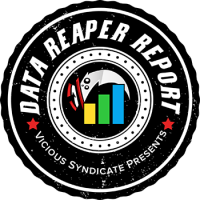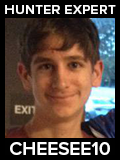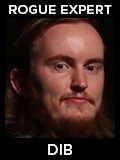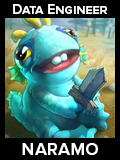
Welcome to the 149th edition of the Data Reaper Report! This is the first Data Reaper Report for Descent of Dragons, following the balance changes.
The next report will be on Thursday, January 9th.
Our Data Reaper Project, including the Data Reaper Live has 3,100 active contributors and we thank them wholeheartedly. Contributing to the Data Reaper project through Track-o-Bot or Hearthstone Deck Tracker (recommended) allows us to perform our analyses and to issue the weekly reports. Without the community’s contribution, there would be no project. Contributing data is very easy and takes a few simple steps, after which no other action is required. If you enjoy our content and would like to make sure it remains consistent and free – Sign Up!
Quick Links
Class/Archetype Distribution | Class Frequency | Matchup Winrates | vS Power Rankings | vS Meta Score | Class Analysis & Decklists | Meta Breaker of the Week | How to Contribute | Credits
Number of Games
| Overall | 45,000 |
| Legend | 8,000 |
| Ranks 1-4 | 13,000 |
| Ranks 5-9 | 16,000 |
| Ranks 10-14 | 5,000 |
Class/Archetype Distribution
[TABS_PRO id=31183]
Class Frequency
[TABS_PRO id=31184]
Class Frequency Discussion
After the utter domination of Galakrond Shaman in the first week of Descent of Dragons, the balance changes have drastically shifted the landscape. Rogue was considered by many players to be the 2nd strongest class before the patch, and it has moved to the top of the frequency charts after the patch. Rogue is also very diverse, with several archetypes seeing play.
Highlander Rogue is the most popular Rogue deck, and the most popular Hearthstone deck at legend. It was refined early, with a stable build that has seen success by many players over the last week.
Deathrattle Rogue is dominated by the Warbringer “Quest Rogue” build. Valeera is running Stonetusk Boars and Vicious Scalehides once again, triggering trauma among many players.
Galakrond Rogue is the most diverse, and least refined archetype. It carries multiple approaches and different packages. Most Galakrond Rogues are running a hybrid deck alongside an Apothecary deathrattle package.
Warrior is the most popular class at the rank 4-1 bracket. It is mainly split between Galakrond Warrior and Pirate Warrior, and both decks are very influential in the current meta. Note that there are some Pirate Warriors that run a Galakrond package, and we count them as Pirate Warrior.
Hunter is extremely popular at lower ranks, thanks to the explosion of Face Hunters a few days into the expansion. Face Hunter is the most popular deck outside of legend, but its presence is noticeably lower at legend. Highlander Hunter is still around, while Quest Hunter maintains a minimal presence.
Shaman’s frequencies have shrunk substantially, and it sits behind the top 3 classes at all rank brackets. Most Shamans are still Galakrond Shamans attempting to adjust the deck to the nerfs it was hit with. We’ll see how they’re doing later. Small numbers of Quest Shamans (running Galakrond too) and Aggro Shamans make up the rest of the class.
Warlock’s presence was given a boost by the patch. Handlock is slightly more popular than Zoo Warlock at the moment, but this could change by the next report. Galakrond has been completely embraced by Zoo, while it’s seeing some play in Handlock builds.
Priest looked dead in the early days of the expansion, but its poor global win rate was a result of the popularity of Galakrond Priest, which birthed some of the worst decks you could imagine. The balance changes awakened Priest’s older archetypes, with Resurrect Priest leading the charge, followed by Combo Priest.
The Druid class has attempted to gain traction through many different decks, but none of them have really caught on. The most popular Druid deck these days is Token Druid, utilizing the Treant synergy cards it has received in DoD.
Cyclone Mage has fallen off before it even arrived, and Mage is now heavily focused on its Highlander archetype. While the deck is fairly common, it’s not enough to pull the class away from being one of the least popular in the game.
Paladin sits at the bottom in most brackets, and much like Druid, it’s a fractured class that has attempted several different things with little to show for it. Ironically, the Paladin deck that’s barely changed in this expansion is the most popular: Holy-Wrath.
[TABS_PRO id=31185]

[TABS_PRO id=31186]
vS Meta Score
[TABS_PRO id=31187]
vS Power Rankings Discussion
Before we go into the analysis of these results, we’ll remind you what we always do on the first report of an expansion or a patch. In the early days of any meta, archetypes are less refined than they usually are. Players still don’t know what cards they should play (because we haven’t told them!). Different decks are at different stages of maturity, which means that the deck with the higher win rate today may not be the strongest deck down the road. It’s also hard to evaluate each deck’s scope for improvement. Our goal is to take these numbers in the context of each deck’s development and provide you with the best assessment of their power level.
At the moment, Warrior looks like the strongest class in the game, with two decks that perform at the highest level. Pirate Warrior is back in business, taking names and smashing face. Galakrond Warrior looks like the best deck in the game, and it’s still deep in the process of refinement. The only deck that seems to consistently give it problems is Resurrect Priest.
Face Hunter is a bait. It still performs well at low ranks, but its win rate takes a sharp nosedive as we reach the upper end of ladder. It’s particularly weak on the climb to legend from rank 4 due to its terrible matchup against Galakrond Warrior. This performance slightly improves at legend due to the prevalence of Rogue, but Face Hunter remains very mediocre. We don’t think it will completely disappear, but it’s very likely that its current popularity is only temporary, and it’s about to fall hard once the meta settles down.
Indeed, Highlander Hunter looks like a better deck than Face Hunter, with more staying power in the long term, while Quest Hunter should also be taken into consideration. If Face Hunter declines, Quest Hunter should receive a major boost, as it is its worst matchup, by far.
Rogue’s performance is aligned with Face Hunter’s presence. Generally, the higher you climb ladder, the fewer Hunters you see, and the better Rogue performs. This bodes well for Rogue’s future, as the meta may become more favorable to it over time. Let’s expand on its three archetypes for a moment:
Highlander Rogue looks pretty good, especially at legend, but we’re not sure it’s the best Rogue deck as it’s perceived by many. It was refined and figured out early, while the scope for improvement in other Rogue decks seems to be higher.
The Warbringer Deathrattle Rogue feels inconsistent because it creates a very draw-dependent and polarizing experience, but it seems to carry the highest ceiling of performance. Zephrys is nice, but two Apothecaries are better than one. We won’t be surprised if the tide within the class shifts back to this deck, especially if Face Hunter declines. When Valeera starts playing Stonetusk Boars, you know what usually happens next. The one thing to keep in mind regarding Warbringer Rogue, is that unlike old Quest Rogue, slower decks can actually target it with effectiveness, so it might not be as dangerous as it looks if it becomes more popular. Who are we kidding? DANGER DANGER DANGER. ROGUE IS PLAYING STONETUSK BOAR.
Galakrond Rogue might be the weakest performing Rogue archetype, but it’s also the least refined one. In other words, much garbage is played here, so we can’t really tell how good it can be until it settles into a couple of builds instead of 10. Considering its win rate is currently around 50%, that’s indicative of potential rather than stagnation.
Resurrect Priest is looking quite strong, but the future of this deck is quite complicated to think about. On one hand, it’s the only hard counter in the game to Galakrond Warrior, which is the best deck in the game on the surface. On the other hand, it’s the biggest counter to Face Hunter, and much of its success is the result of this matchup’s popularity. Add a very polarizing matchup spread in general and you have the recipe for what will likely be a very inconsistent deck. Resurrect Priest’s performance noticeably declines at higher levels of play, and some of the decks that may rise in the near future do not give Priest a good time, so we’re quite wary of how long its success will last. With Galakrond Priest looking like hot garbage, and Combo Priest not impressing us too much either, Anduin could be in trouble down the road.
Galakrond Shaman’s win rate has dropped to manageable levels, and all is right in the world. Or is it? When we evaluate the builds of the archetype, we identify a sleeping giant. Most players have not found the best way to adjust to the balance changes, but there is one solution that could be the catalyst that launches Galakrond Shaman back to the top of the meta. Read the Shaman section. Ribbit.
One class that the balance changes may have saved is Warlock. It looked dreadful before the patch, but Zoo Warlock is looking quite competitive now. It has good matchups against all Rogue archetypes, and it will appreciate a decline in Face Hunters. However, we don’t anticipate it becoming a top tier deck because of its issues against Warrior and Shaman. Those Galakrond hero powers are a big problem for the deck. Handlock should also greatly benefit from seeing fewer Hunters, and its matchup spread exhibits some promise. As long as the top tier decks don’t grow too much in strength, it’s too early to write this deck off.
The meta at the top level is looking fairly balanced so far, which is encouraging to see, but balance does not exist in the lore of this expansion. In the battle between Good and Evil, Evil is kicking Good’s ass. The Explorer classes are struggling to compete with the Galakrond classes, as shown in the struggles and lukewarm performance of Druid, Hunter, Mage, and Paladin.
Druid has had a pretty bad expansion so far, with one major hope, which is Token Druid, looking okay. We think this deck has some places it can improve on too, so there’s a chance it won’t be left in the dust kicked by the top meta decks.
Mage is mostly waiting for Face Hunters to go away and hoping it will be enough to lift Highlander Mage from its current predicament. Mage might be able to deal with the rest, but this one matchup is just hell. There’s nothing else that looks remotely viable in the class.
Paladin is the one class that looks to be in genuine danger of becoming completely irrelevant. Holy-Wrath Paladin is a weak ladder deck because of the high presence of Rogues, while players have yet to find a list that would move Highlander Paladin out of the generous Tier 4 placement we gave it. Pure Paladin is a pure disaster.
Class Analysis & Decklists
Druid | Hunter | Mage | Paladin | Priest | Rogue | Shaman | Warlock | Warrior
Rogue is one of the strongest classes in the game, and it has seen the most varied and vast experimentation out of all the classes in the format. In this section, we will pinpoint the most promising avenues that players should go to.
We’ll start with the easiest one, which is Highlander Rogue. Unlike other Rogue decks we will discuss, Highlander Rogue has stabilized around a singular build very quickly and took off from there. As a result, Highlander Rogue has also been the most popular, and most consistently successful Rogue deck. Nobody needed to think very hard about Highlander Rogue, since the job was already done for everyone by Jambre, who crafted a Rogue deck with the best 30 cards available to the class and took it to #1 legend very early in the expansion. Tyler tweaked the list a little bit and took it to #1 legend after the balance changes.
We’ve got an Apothecary package, a Vendetta package and a Galakrond package topped off by the Highlander payoff cards. The list featured is close to what both players were running. Simple and effective.
Next, we have the pure Deathrattle Rogue, centered on Necrium Apothecary. While a Mechanical Whelp variant has seen a little bit of play, the Anubisath Warbringer variant (“build your own Quest Rogue”) is the more popular and successful one. This archetype has been more difficult to refine. The key takeaway from our research is that Magic Carpet sucks, and Necrium Vial is underrated. Apothecary is very often ignored when it’s played, so when you play Vial on it, you pretty much win the game unless your opponent kills you on the very next turn. Furthermore, Vial is very good with Anka, since it offers you a massive hand buff without any response from the opponent, who can still silence or transform your Apothecary to disrupt your game plan. Wisp is a card that might be strong enough with Vial, and could be slotted in instead of Pharaoh Cat.
One note on the mulligan. We’ve seen players overkeep cards that aren’t Apothecary or Anka. This deck lives and dies by drawing these specific cards. This may seem slightly hyperbolic, but none of the other cards matter. Don’t keep Flybooter, Cat, and Miscreant to “fend off aggression” when you don’t have Apothecary. Don’t keep Blade when you don’t have Apothecary. You want Apothecary, Apothecary, Anka, and Blade, in that order, and you can keep Backstab if you have an Apothecary to activate when going first. The other cards are only keep considerations when you already have what makes your deck function. If you haven’t noticed by now, it’s Apothecary. Warbringer Rogue without Apothecary is a Quest Rogue without the quest.
Finally, we have Galakrond Rogue, and this archetype is the least refined out of the three major archetypes, which could be why its win rate is the lowest. However, should it solve the puzzle of its optimal build, it could end up looking stronger, so it’s difficult to say how good it really is at this stage.
The first decision when building Galakrond Rogue is about the secondary win condition alongside Galakrond. Variants are split between Necrium Apothecary and Questing Adventurer, and Apothecary seems to possess the higher ceiling.
The second decision is whether we run Mechanical Whelp or Anubisath Warbringer, and the answer is unclear. This may surprise some, but Galakrond Rogue will usually have a hand full of lackeys, and it can overwhelm the opponent through the buff as often as it does with a 7/7.
This leads us to “two” featured lists. J_Alexander is responsible for the main Whelp version, while the “tech cards” listed are what you’d replace the “flex cards” with when running the Warbringer version.
Heh, Greetings. Warrior has arguably looked like the strongest class in the format following the balance changes, which were crucial in pushing two of its archetypes into an elite position.
Galakrond Warrior might be the best deck in the game. It couldn’t compete whatsoever with Galakrond Shaman on the first week of the expansion, but the nerfs to Shaman have given it new life and elevated it to the top of the meta.
Despite performing so well, Galakrond Warrior still has room for improvements. The most common build, which was popularized by BoarControl, runs multiple self-damage mechanics and a combo finisher with Leeroy Jenkins, Inner Rage and Bloodsworn Mercenary. However, this OTK package hasn’t been stellar, with many of its cards proving to be situational and weak by themselves. In particular, Whirlwind and Battle Rage have been extremely underwhelming and we don’t think they’re ever worth including.
The strongest card in the deck has been Scion of Ruin, and ZachO has attempted to maximize its potential while running independently stronger cards such as Livewire Lance, Zilliax and Deathwing. The most important aspect of the build is running Dragon Breeder and Barista Lynchen, with the goal of repeatedly copying Scion of Ruin and dominating the board through its usage. The Breeder/Barista package has performed exceptionally well and we believe it to be core to the deck, regardless of what variant you end up using.
There is an option to flex the Mercenary package back in, replacing the cards we’ve highlighted in the list as flex cards. The featured build performs significantly better in Warrior mirrors (and against most other classes, such as Shaman), while the Mercenary package improves the Rogue matchup, since it gives you early blow out potential and bigger reach in the late game. One important thing to remember about the Rogue matchup is Flik Skyshiv. When duplicating Scion of Ruin, you can consider (depending on the situation in the game) to use them strictly for removal. Run the Scions into minions and have them die, while not leaving them on the board. It’s quite easy to do and and gives no opening for the Rogue to win the value battle through Flik sacking your Scions.
Pirate Warrior has also been performing exceptionally well, and unlike Galakrond Warrior, its optimal build was figured out very quickly, with Skybarge, Sky Raider and Parachute Brigand proving to be great additions. The most remarkable trait of the deck is its resource management and longevity, which is in stark contrast to the Pirate Warrior of Mean Streets of Gadgetzan. Ancharrr, Livewire Lance and Hoard Pillager can often outvalue slower decks. Ancharrr, in particular, is an extremely powerful card that has a Keleseth/Barnes level effect on the deck’s win rate when drawn early.
In case you’re wondering, we haven’t been impressed with a Pirate/Galakrond hybrid deck. It looks largely inferior.
Finally, we’ve seen drips of Control Warrior and Bomb Warrior around ladder, but all of their builds have proven to be quite weak. The old Warriors seem to be struggling under the pressure of the DoD meta, which carries a lot more value thanks to Galakrond and other powerful resource engines that have been introduced in this set. That doesn’t bode well for archetypes that are reliant on depleting the opponent’s resources to win.
Face Hunter was one of the breakout decks of the expansion, rapidly gaining popularity thanks to its low cost. Its other advantage was being one of the only decks that could somewhat handle the highly oppressive pre-nerf Galakrond Shaman, while also burning down Rogues. However, the balance patch has drastically changed the meta, and Face Hunter is falling out of favor. The rise of Galakrond Warrior, the linear and one-dimensional playstyle of Face Hunter as well as the ease with which it can be countered through life gain are all factors in its quick fall from grace.
While we don’t expect to see Face Hunter remain a prominent deck in the field, it does have a chance to improve should it continue to refine. Popular builds of the deck are far from being optimal. The biggest mistake is running 6 secrets alongside Phase Stalker. Face Hunter never wants to draw secrets as they don’t offer any pressure or immediate damage against the opponent. Old school players will remember how Hunters ran two Mad Scientists alongside just two Explosive Traps after the launch of Naxxramas, and this is the correct approach today.
With the space available by cutting bad secrets, Face Hunter should run more early game minions, especially 1-drops. While the best turn 1 play in the deck is Toxic Reinforcements, cheap minions give you something to do in case you didn’t draw the quest, or when you have some leftover mana while weaving in hero powers. This is why we recommend running Dwarven Sharpshooter, Leper Gnome and Blazing Battlemage all together. Timber Wolf is another weak card that’s very popular in the deck, while Kobold Sandtrooper is relatively underplayed despite performing well.
Highlander Hunter will likely end up being the stronger Hunter deck with a better chance of surviving in the DoD meta, and this archetype’s ladder builds are also far from optimized. Common builds seem split between Stormhammer Dragon builds and Zul’jin Spell builds, yet we believe that excluding either package is detrimental to the deck.
The featured list incorporates both packages while providing maximum support to Veranus through Desert Spear and Springpaw. Strangely enough, we’ve seen common builds use Veranus yet not include these support cards. He’s quite weak without them.
Quest Hunter sees a little bit of play, and we wouldn’t rule out the possibility of the deck rising in the future, especially when Face Hunter declines (really difficult matchup). It has a good matchup spread against the top meta decks, which suggests it may have a place in the DoD meta. Potential sleeper.
Before the balance changes, Shaman looked like one of the strongest classes we could remember. Needless to say, the meta was in an unhealthy state, which sparked the fastest post-expansion balance changes in the history of Hearthstone in order to address it.
Galakrond Shaman is no longer an absolutely dominant tyrant of the meta, but it’s still strong, and we suspect that it can only get better. The most important finding regarding this archetype is that a new build is beginning to appear, and it’s far superior to the rest.
This build is centered on Spirit of the Frog and a package of spells that perfectly answer common meta threats. Earth Shock and Hex are very powerful against Rogue. Witch’s Brew is great against Hunters. Earthen Might is almost always active and is very good at seizing tempo against Warriors specifically. While Mogu Fleshshaper is no longer a consistent keep in the mulligan, it’s still a powerful draw later in the game and a good Mutate target, another spell you want to use with Spirit of the Frog.
The addition of this powerful draw engine has done wonders for the post-patch Galakrond Shaman. It accelerates your Galakrond-related power spikes, and makes the spell-centric legendary package of Zentimo, Vargoth, and Electra much more consistent. The synergy in this deck is simply incredible, and we highly recommend trying it. You’ll quickly realize that Galakrond Shaman is here to stay, and might return to Tier 1 before long.
Aggro Shaman has been somewhat abandoned, but we think it might be too early to write it off. The main takeaway of the balance changes is that Mogu Fleshshaper/Mutate is now too slow of a combo to include. However, Doomhammer builds have the potential to give Rogues a lot of problems, so we’re curious whether one can emerge.
Quest Shaman was an inferior take on Galakrond Shaman before the balance changes, and this is certainly true after the balance changes. The archetype has drastically faded away, and based on how it’s performing, there’s a good reason why. It sucks.
Warlock looked hopeless with the launch of the expansion. Both Zoo and Handlock crumbled under the weight of Shamans, Face Hunters and Rogues, and it looked like our assumption that it would be the worst class was close to the truth. However, the balance changes renewed optimism that Warlock could be competitive, and while it isn’t looking incredible, it’s not sitting deep in the dumpster at this stage.
Galakrond Zoo Warlock benefited from Galakrond Shaman’s slowing down, and the deck is actually allowed to have a board these days. Pizza has been having success with a Zoo list that looks fairly streamlined. One thing we have noticed is the drop in power level of Faceless Corruptor after its nerf. It’s no longer a card we should consider to be an automatic inclusion. While the Galakrond cards perform relatively worse in the deck than Galakrond cards in other classes, all of them should still be run in the deck, as it’s a parasitic mechanic that drops in power the more you reduce its presence.
Handlock has been having more success running a pure dragon build instead of incorporating any Galakrond package. The main takeaway is that Sunfury Protector is not pulling its weight. It’s historically been a card used in Handlock decks of the past, but is very underwhelming these days. It’s better to run strong, standalone taunts than hoping to develop defense that relies on being ahead. This is why Evasive Drakonid has been a surprisingly good addition to the deck. Khartut Defender is also an option, but Handlock really wants to pressure opponents, and Defender is not very threatening.
Priest finds itself in a deceptively precarious situation. Its DoD set has mostly been a failure so far. It hasn’t been able to leverage Galakrond and Fate Weaver to a competitive deck, and most of its new cards have fallen flat on their face as well.
And yet Priest is currently plugging along with its old SoU decks. Admittedly, Combo Priest is weaker than before after adding no new cards while seeing the field grow much stronger. However, Resurrect Priest is having a good time beating Hunters and Warriors, and is one of the stronger ladder decks in the game. So far.
Key phrase, so far. Resurrect Priest’s problem is that once Face Hunter fades away, it’s left with the headache of dealing with Highlander Rogues and Shamans, while Warrior could also be on their way to improving this specific matchup.
So at the moment, Priest is doing well, but the future may not look too bright if the meta moves in the direction we think it might be headed. If a new discovery in the class isn’t made, Priest could spiral down to mediocrity, or worse.
Druid has had a disappointing expansion so far, with all of its archetypes failing to gain traction. Embiggen performs like a powerful card, but it promotes a midrange deck that is susceptible to the incredible removal and rush minions available to other classes. The battle for tempo has crept up in power level significantly, and the class is struggling to keep up.
Quest Druid has also fallen off to the wayside. We’ve seen builds incorporating a small dragon package with Breath of Dreams and Ysera Unleashed, but they perform so poorly that they will likely fade away from the scene. Highlander Druid is also headed to where it was during Saviors of Uldum: non-existence.
The only Druid deck that looks competitive is Treant Token Druid, thanks to the treant tribe receiving a few key upgrades: Goru, Shrubadier, Treenforcements, and Aeroponics are all fantastic cards in the deck.
The archetype is slightly suffering in its win rate due to card selection inertia. Players began with running cards that have historically been used in the archetype, but aren’t delivering. The most notable ones are Soul of the Forest and Blessing of the Ancients. Both require a big board to be useful, which is difficult to maintain in the current meta. Treant Token Druid is also a slower deck than before, which means that Blessing of the Ancients is harder to get value of, with the deck having a higher curve and being generally less “floody”. Power of the Wild is also relatively underwhelming, but its added flexibility makes it less of a dead draw.
Mage has had a tough couple of weeks. The much-hyped Highlander Mage has delivered disappointing results so far, while Cyclone Mage looks very far away from being a playable deck. The power level in other classes just seems to be too much for Jaina to handle.
However, there is some room for optimism in the class when looking at future meta trends. Highlander Mage’s worst matchup is Face Hunter, and nothing else comes close. When you take out this one horrid matchup, it actually lines up pretty well against the field. It can fight off Shamans and Rogues, it dominates Priest, and it only slightly struggles against Warrior.
So if Face Hunter theoretically disappears (which may not be too far from what actually occurs), Highlander Mage’s win rate will significantly climb. Will it climb to the top of the meta? Unlikely, but it may land in a very competitive spot.
When it comes to Highlander Mage’s build, we’ve found a couple of key insights. Both Frostbolt and Doomsayer are very weak at the moment. The meta doesn’t have too many early game minions that warrant removal, while the top meta decks usually handle Doomsayer very easily: it’s nearly useless against most of them. You’re much better off trying to find your game-winning cards than hoping to delay aggression on turn 2, and drawing either card at a later stage in the game hurts you more often than not.
The situation looks grim for Paladin. Its Highlander archetype looks like a dud. Its dragon synergy is weaker than Druid’s, so it has no chance to compete for tempo against the best classes with its handbuff mechanics. So far, it looks like it only has a couple of barely competitive decks to take into ladder.
We will say that the tournament scene is a bit different. The availability of a ban means that Holy-Wrath Paladin can avoid its hardest counter class in Rogue (Flik Skyshiv is a nightmare in this matchup). It has some very good matchups against classes that aren’t Rogue or Warrior, so we can see it having success in conquest format. However, running into your worst matchups on ladder is a very common event, and a painful one for the deck’s ladder win rate.
Mech Paladin is the only Paladin deck that has a non-terrible ladder win rate, but that doesn’t inspire confidence that it will make it as a competitive deck. We’ve slightly tweaked our theorycrafted list after evaluating the performance of some of its cards, and it could be a serviceable deck. We’ve also seen other builds that run Mechano-Egg and Kangor’s Endless Army, and these cards’ performance is horrendous. Don’t do it to yourself.
We think Rogue, Warrior, and Shaman are the best classes in the game, and in this section, we will reiterate the three most promising avenues for each of these classes.
Galakrond Warrior looks extremely powerful and is likely the best ladder deck today. The build we’ve featured was made in our own lab, and has already spread and seen a lot of success by several top players. It looks to maximize Scion of Ruin abuse to the greatest extent, and dominate board while whittling down your opponent with your Galakrond hero power. There is still the option to add the combo package, but it’s difficult to tell whether the meta is headed in a direction that would welcome it or not.
Deathrattle Rogue exhibits scary potential, and while all Rogue archetypes look good, this deck might be the most likely to “break” the current meta, or break your will to live. Whenever aggressive decks decline, this deck can deliver severe punishment and oink out charging 10/10’s. Understand which cards actually matter (answer: there are two) and you’ll do better with the deck.
Galakrond Shaman is not going anywhere, and we think it has the potential to return to the top of the meta. Perhaps, it won’t be as oppressive as it was at the launch of the expansion, but the featured list looks really, really good. Trust the frog, for it will deliver you spells of increasing costs… and victory.
Our Data Reaper Project, including the Data Reaper Live has 3,100 active contributors. Without them, this project would not be possible, so we’d like to thank all of our contributors for their help.
Preparing our weekly article requires a significant amount of time and effort from many individuals. We would like to wholeheartedly thank our current Patreons, whose generous donations help us fund computing and server costs.
vS Gold is a new membership plan aimed to support our efforts towards improving our content and data analysis while receiving some bonuses and extra features.
Tier 3+ Patrons
Special thanks to Leo G, Aaron B, Jed M, Drew M, Alan J, Zolstar, Sean H, Steve F, Andrew N, NObdy, Alonso P, James Y, PinkMageDiaries, Je-ho, Ziqiao Y, Stephen H, William H, Patrick L, 1RiceBowl1, and Alex S for supporting us for the month of December.
Contributors
Here are all the people that participated in bringing you this edition of the vS Data Reaper Report:






























Are there any stats with players running the Galakrond Warrior without the value package of Barista Lynchen and Dragon Breeder? I had a fairly successful climb on ladder till rank 4 (25-10, I think, don’t have HS replay handy) running a purely tempo build. My substitutions for these 3 cards are 2 Sky Raiders and 2 Frothing Berserkers (with the additional exclusion being Deathwing).
Thanks for the write-up, vs team.
You may want to look at the galakrond frog shaman list as it still show mogu as 7 mana, though
Can I just say that this new way of presenting the deck lists makes it really unclear what list the deck code is for and to me, probably reduces the value of the lists provided in the report.